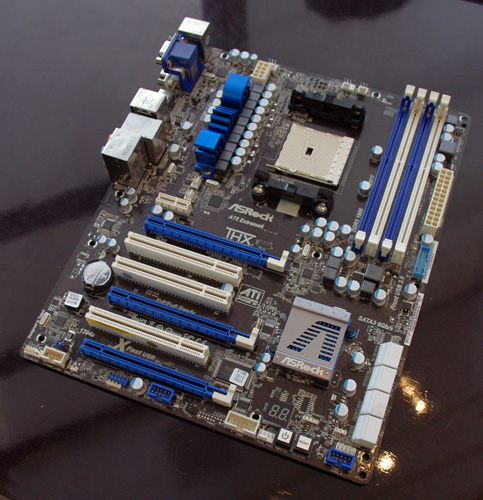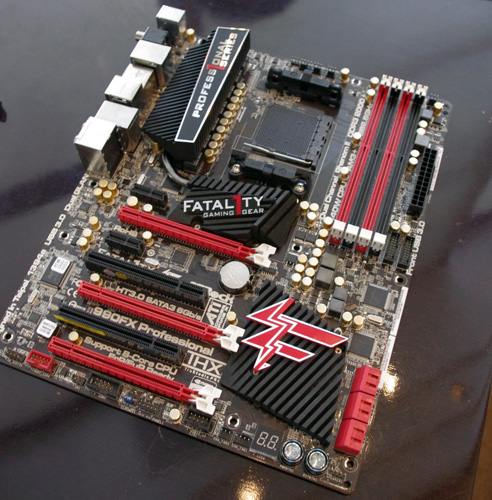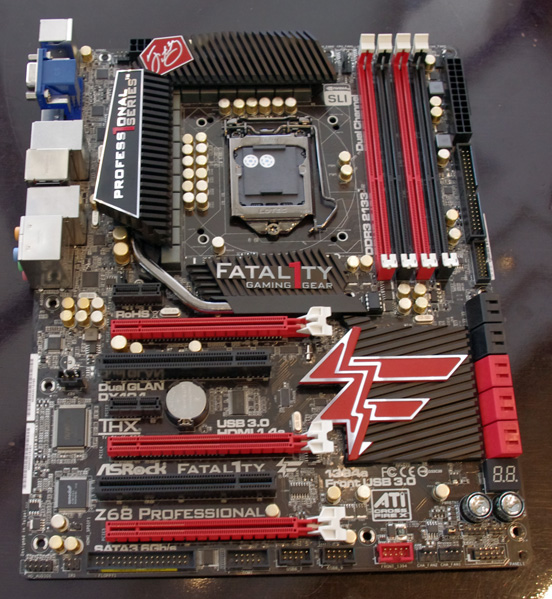Computex 2011: ASRock Llano, 990FX and Z68 Motherboards
by Anand Lal Shimpi & Ian Cutress on May 30, 2011 1:36 AM EST- Posted in
- Motherboards
- ASRock
- Computex 2011
- Trade Shows
Computex 2011 is officially underway. Although technically it started yesterday with informal meetings at LAX, Ian and I kicked off our plethora of meetings at the show today with ASRock.
ASRock met with us this morning bearing goodies, three new motherboards to be specific.
First up was the A75 Extreme6, ASRock's Socket-FM1 motherboard designed to accept AMD's A-series Llano APUs. A number of leaks have already happened around Llano so if you want more details I'd suggest going to the source at this point. We're working on coverage of the platform but it'll be a little while longer before we can post on it.
Llano is mainly targeted at mobile systems first, but we will see desktop platforms going forward. Llano will become AMD's mainstream desktop CPU over the coming quarters, replacing the Athlon II and Phenom II in many cases.
Just above Llano we will have the long awaited Bulldozer CPU. AMD originally wanted to launch Bulldozer at Computex but performance issues with its B0 and B1 stepping chips pushed back the launch. Now we're looking at a late July launch with B2 silicon, but performance today is a big unknown. Apparently the performance of B1 stepping silicon doesn't look too good.
Bulldozer will be mechanically compatible with Socket-AM3 motherboards but AMD will only officially support the CPU on AM3+ motherboards. To differentiate AM3+ from AM3 motherboards AMD is releasing a new chipset: the 9-series. Functionally the 9-series chipset is no different from the 8-series that it replaces; it'll simply be used on AM3+ boards exclusively.
ASRock showed us its high-end 990FX motherboard: the Fatal1ty branded 990FX Professional:
Obviously a very high end motherboard, ASRock included two front panel USB 3.0 headers on its 990FX board. There are also three PCIe x16 slots and six 6Gbps SATA ports driven off of the 990FX chipset itself.
Finally we have ASRock's Z68 Professional motherboard, once again with Fatal1ty branding. At Jonathan Wendel's (Fatal1ty) request, the Z68 Professional includes an IDE port for optical drives and a floppy drive connector as well.
We've got several more meetings lined up so expect more coverage from the show today.



















39 Comments
View All Comments
m.amitava - Monday, May 30, 2011 - link
If B1 stepping performance for Bulldozer doesn't look too good, can we really expect a magical jump within one more stepping? was hoping Bulldozer would be competitive :(....Intel's having it faar too easy in the enthusiast segment...dezz - Monday, May 30, 2011 - link
Most probably there is a little hw bug that is preventing it to reach the intended clockrates. (BD is desingned to work at high clockrates, at least some parts of it.) If it gets fixed it's ready to go...So, it's not about redesigning the whole thing in a new stepping.
Targon - Thursday, June 2, 2011 - link
It may not be about clock rates, and more about design errors that cause logic problems in how instructions are executed. These errors can be discovered and fixed, which of course means a new stepping. Now, there is one other issue here, and that is about the speed of the chips. As long as AMD can come up with a chip that performs as well as an Intel chip at the same price point, AMD will sell quite a few processors.Let's face it, most people don't look to buy the very fastest CPU or GPU, but look to get the best bang for their buck. Even something that performs on par with the Phenom 2 965 is easily something that will sell fairly well if the price is right, and Bulldozer SHOULD be quite a bit faster, clock for clock. The problem right now is that AMD is having problems competing with the Intel i5, so the CPU performance of Bulldozer is critical.
dezz - Friday, June 3, 2011 - link
I think such kind of errors show up during initial product evaluations (rev.A0, A1), even early simulations. There are Enginering Sampes out (B0, perhaps B1) since last year that works well - at moderate clockrates.nonameo - Monday, May 30, 2011 - link
what? floppy? I might could see the point in an IDE connector but floppy?I just don't get it. why?
cozappz - Monday, May 30, 2011 - link
'cause I hate to throw away a good functional FDD I bought in the autumn of ninteen hundred ... something ;) .JarredWalton - Monday, May 30, 2011 - link
Yeah, I'd like to know what Fatal1ty's background in computer hardware is, that he should think the inclusion of IDE and floppy support is still important. USB flash drives have killed off the floppy (unless you're installing XP still?), and IDE hasn't been useful for anything beyond DVDRs for years.Targon - Thursday, June 2, 2011 - link
Some people still have old data on floppy they want access to, and having a floppy drive in ONE computer, just for that reason alone may be worth having the connector. I agree that the floppy drive is dead technology, but some people out there keep trying to raise the dead.Mr Perfect - Monday, May 30, 2011 - link
I don't even see why he'd want an IDE port. SATA DVD burners are what? $30 or less on Newegg? Who exactly is going to buy an high end premium motherboard and not have the $30 to get a DVD burner that was manufactured in the last five years?Jinxed_07 - Saturday, June 25, 2011 - link
I, like you, thought this for a long time. But it has since occurred to me that some people like to keep ALL of their SATA ports open for HDD's or SSD's only. I could compromise in this area all thought I'd rather not. Now, sure, they could buy an external CD/DVD burner, but I'm sure performance times would be significantly slowed down.